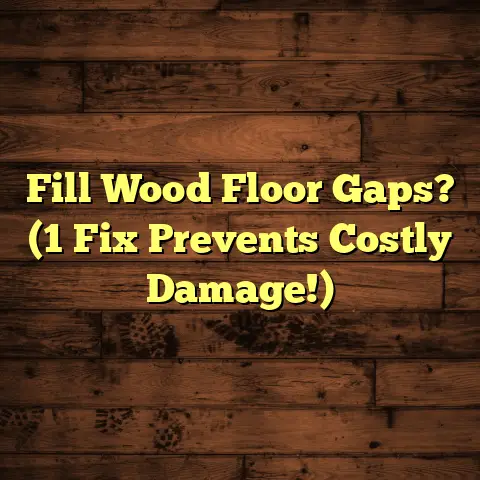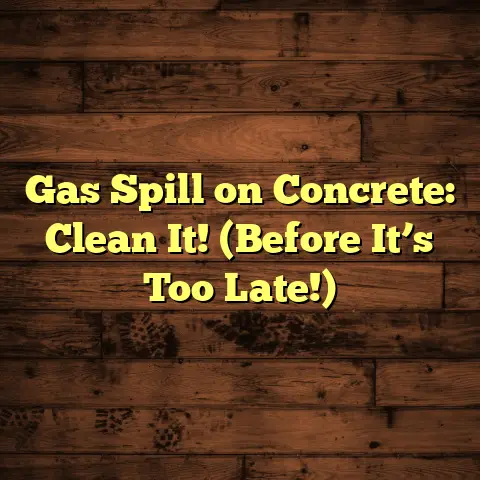Can Vinyl Floor Be Installed Over Concrete? (Explained)
I remember the first time I stepped onto a beautiful vinyl floor.
It was in my childhood home, and it felt like walking on clouds.
The warmth, the colors, and the patterns made the space feel alive.
Fast forward to today, and I find myself often revisiting those feelings, especially when I’m working on flooring projects.
Can Vinyl Be Installed Over Concrete?
As I dive into the world of flooring options, one question that comes up frequently is whether vinyl can be installed over concrete.
After years of experience, I can say from personal experience—yes, you absolutely can!
However, there’s more to it than just laying down sheets of vinyl on a concrete slab.
Preparing the Concrete Surface
Before you even think about placing vinyl over concrete, preparation is key.
I once went into a project where the concrete was uneven and had all sorts of cracks.
Let me tell you, that was a nightmare.
Not only did it require extra work to level the surface, but it also delayed the entire project timeline.
Steps for Preparation:
- Inspect for Cracks: Make sure to check for cracks and holes.
Fill them with a concrete patch compound.
This is crucial—if the surface isn’t smooth, it will impact the vinyl installation. - Clean Thoroughly: Dust and debris can hinder adhesion.
I usually use a vacuum followed by a damp mop to get it sparkling clean. - Leveling Compound: If you find that your concrete is still uneven after patching, consider using a leveling compound.
It’s worth the investment in time and money. - Moisture Testing: One thing I learned the hard way is to test for moisture.
Vinyl is not a fan of moisture, and if your concrete slab has too much moisture, it could lead to mold or warping over time.
A simple plastic sheet test can help determine this.
Types of Vinyl Flooring
Now that your concrete is prepped, let’s talk about the types of vinyl flooring you can install over concrete.
1.
Vinyl Plank Flooring: This option mimics hardwood and comes in interlocking planks, making installation easier.
I often recommend this style for clients who love the look of wood but want durability.
2.
Vinyl Sheet Flooring: This is a continuous sheet of vinyl that provides a seamless look.
It’s great for larger areas as it minimizes seams that can trap dirt and moisture.
3.
Luxury Vinyl Tile (LVT): This is like a hybrid between plank and sheet vinyl.
It offers both style and durability and comes in various designs.
Installation Steps
After choosing your vinyl type, it’s time to get to work!
- Acclimate Your Materials: Allow the vinyl to sit in the room where it will be installed for at least 48 hours.
This helps it adjust to the temperature and humidity of the space. - Lay Down Underlayment (Optional): While not always necessary, using underlayment can improve comfort and sound insulation.
- Start Installing: Whether you’re using glue or a click-lock system, follow the manufacturer’s instructions closely.
- Trim Edges: After installation, trim any excess material at the edges for a clean finish.
Cost Considerations
One aspect that often comes up with my clients is cost.
Vinyl flooring can be an economical choice compared to hardwood or tile, but costs can vary based on material type and installation method.
Using FloorTally has been a game-changer for estimating costs accurately.
It pulls local material rates and helps me create precise budgets for my clients.
For instance, I recently worked on a project where we installed 1,000 square feet of luxury vinyl tile over concrete.
Using FloorTally, I was able to estimate the total cost—including materials and labor—within minutes rather than hours of calculations.
Challenges Faced
While installing vinyl over concrete can be straightforward, challenges do arise.
- Moisture Issues: I once had a client who didn’t listen to my advice about moisture testing.
They ended up with mold under the vinyl after installation, which meant tearing everything out and starting over. - Uneven Surfaces: As mentioned before, I’ve faced issues with uneven concrete slabs which required extra leveling work.
Always be upfront with clients about these potential challenges.
Maintenance Tips
Once your vinyl flooring is installed over concrete, keeping it looking great requires some maintenance:
- Regular Cleaning: Sweep or vacuum frequently to avoid scratches from dirt and debris.
- Use Appropriate Cleaners: Avoid harsh chemicals; instead, use a mild detergent mixed with water for mopping.
- Protect from Heavy Furniture: Use felt pads under furniture legs to prevent dents.
Comparative Analysis
When comparing vinyl flooring with other options like laminate or tile over concrete, here’s what I’ve found:
- Cost: Vinyl usually comes in lower than both laminate and tile.
- Comfort: Vinyl offers more warmth underfoot compared to tile.
- Installation Ease: Vinyl is generally easier to install than tile, which often requires grout and more intricate work.
In my experience, if you’re looking for affordability and versatility, vinyl truly stands out as an excellent choice for installation over concrete.
Personal Anecdotes and Insights
I remember a particular job in a modern loft where the owner wanted to replace outdated carpet with something fresh yet easy to maintain.
We decided on luxury vinyl planks because they offered both style and practicality.
The transformation was incredible!
However, we faced challenges during installation due to uneven sections of the concrete slab.
We ended up using a leveling compound that took an extra day but made all the difference in ensuring that the vinyl laid flat without any bumps or ridges.
Dealing with Adhesives
Using adhesives can be another layer of complexity when installing vinyl flooring over concrete.
- Types of Adhesives: Make sure to choose the right adhesive based on your selected vinyl type.
Pressure-sensitive adhesives are popular for vinyl plank installations because they’re easy to work with. - Application Tips: Apply adhesive evenly using a notched trowel—this helps prevent bubbles from forming under your flooring.
I once had an unfortunate situation where I used the wrong adhesive type on a project.
It resulted in parts of the flooring lifting after just a few weeks!
Learning from that mistake has made me diligent about checking product specifications every single time now.
Environmental Considerations
As more clients become eco-conscious, they often ask about the environmental impact of flooring choices.
Vinyl flooring has made strides in recent years regarding sustainability.
Many manufacturers now produce products that are phthalate-free and made from recycled materials.
If you’re considering this aspect, look for certifications like FloorScore or GreenGuard which indicate low emissions of volatile organic compounds (VOCs).
Long-Term Performance
Over time, I’ve noticed that high-quality vinyl floors stand up well against wear and tear when properly maintained.
Unlike some flooring materials that scratch easily or show wear patterns quickly, good quality vinyl can last for decades in residential settings.
I recall one particular project where we installed luxury vinyl tiles in a busy family kitchen.
Five years later, it still looked as good as new!
The homeowners appreciated how easy it was to maintain while dealing with everyday spills from their children.
Installation Tools You’ll Need
Having the right tools makes a significant difference in the installation process:
- Utility Knife: Essential for cutting planks or sheets accurately.
- Measuring Tape: Accurate measurements are crucial for planning your layout.
- Notched Trowel: If you’re using adhesive, this tool ensures even application.
- Roller or Tamper: Use this to ensure proper adhesion after laying down your vinyl.
- Straight Edge or Square: Helps in cutting straight lines for clean edges.
- Leveling Tools: For checking surface flatness before installation.
Having these tools ready can save you time and frustration during installation!
Comparing Other Flooring Options
When weighing your options for flooring over concrete, here’s how vinyl stacks up against some other popular choices:
- Laminate Flooring: Often less expensive than vinyl but lacks moisture resistance; not ideal for basements or areas prone to spills.
- Tile Flooring: Offers durability and aesthetic appeal but requires more labor-intensive installation; heavier and colder underfoot.
- Carpet: Comfortable but not suitable for moisture-prone areas; harder to clean if spills occur.
- Hardwood Flooring: Beautiful but expensive; requires more upkeep and isn’t suitable for all environments like basements.
In many cases, clients find that vinyl offers the best balance of cost, aesthetics, and functionality when laying over concrete.
DIY vs. Professional Installation
Many clients wonder whether they should tackle an installation themselves or hire professionals.
Here’s what I usually advise:
- DIY Installation: If you’re handy and have some experience with home improvement projects, installing vinyl can be manageable—especially planks with click-lock systems.
- Professional Installation: If you’re dealing with significant subfloor issues or want peace of mind regarding warranty coverage, hiring a professional could be worthwhile.
A friend of mine decided to go DIY on his vinyl plank installation without prior experience; he ended up with gaps between planks that were quite noticeable!
It’s essential to weigh your skills against potential outcomes before jumping into DIY projects.
Future Trends in Vinyl Flooring
As I keep my finger on the pulse of flooring trends, I’ve noticed some exciting developments in vinyl flooring:
- Design Innovations: Manufacturers are creating more realistic wood textures and patterns which enhance visual appeal.
- Eco-Friendly Options: As mentioned earlier, sustainable manufacturing practices are becoming more prevalent.
- Smart Technology Integration: Some newer products even incorporate smart technology that allows you to monitor temperature and humidity levels affecting your flooring!
These advancements make me excited about what’s next for flooring options like vinyl over concrete.
Final Thoughts
If you’re considering installing vinyl over concrete, remember that preparation is everything!
From ensuring your concrete slab is ready to picking the right type of vinyl for your space, each step plays a crucial role in achieving lasting results.
With so many benefits—including ease of maintenance, affordability, and aesthetic versatility—it’s no wonder that vinyl remains a popular choice among homeowners today.
Whether you’re embarking on a small renovation or a brand-new build, take your time researching options that suit your needs best.
And always remember to enjoy the process!
Seeing those nostalgic feelings reflected in your finished flooring will make all your efforts worthwhile.




